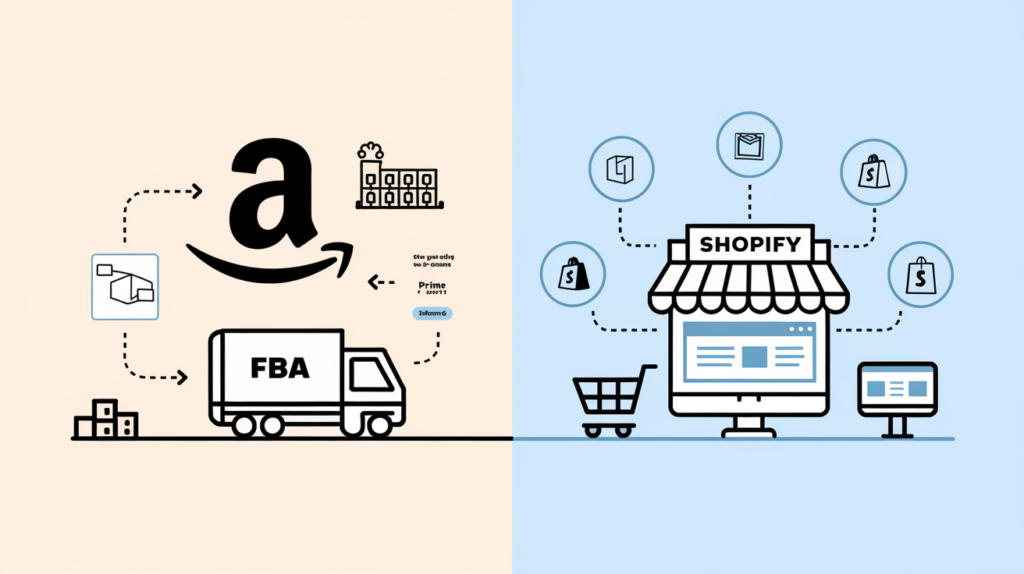Key Takeaways:
- Amazon FBA and Shopify are powerful e-commerce platforms, each with strengths and weaknesses.
- The best platform depends on your business goals, product type, marketing strategy, and resources.
- Amazon FBA offers vast customer access and streamlined fulfillment, but with higher fees and less control.
- Shopify provides greater branding and customer relationship control, but requires more marketing and upfront investment.
- Combining both platforms offers a synergistic approach, maximizing reach and control.
- XOA TAX helps navigate the complexities of either or both platforms to optimize your tax strategy and maximize profits.
Amazon FBA vs. Shopify: Choosing the Right E-Commerce Platform (or Both!)
As a business owner, selecting the right e-commerce platform is crucial. Two popular options, Amazon FBA and Shopify, offer unique advantages. Understanding their nuances is essential for an informed choice. XOA TAX advises clients on the financial and strategic implications of both, helping them select the best fit or a combined approach.
Understanding Amazon FBA
Amazon FBA leverages the vast Amazon marketplace. You list products, and Amazon handles storage, shipping, and customer service.
Advantages of Amazon FBA:
- Massive Customer Base: Tap into Amazon’s millions of Prime members and billions of monthly visitors.
- Simplified Logistics: Amazon manages inventory, packaging, shipping, and returns.
- Trust and Credibility: Benefit from Amazon’s established reputation and customer trust.
- Prime Eligibility: Offer Prime shipping, a major draw for online shoppers.
Disadvantages of Amazon FBA:
- Higher Fees: Amazon charges various fees, impacting profit margins.
- Limited Control: Less control over branding and customer relationships.
- Competition: The marketplace is highly competitive.
- Platform Dependence: Your business is tied to Amazon’s rules.
Exploring Shopify
Shopify lets you create your own online store, controlling design, branding, and customer experience.
Advantages of Shopify:
- Branding Control: Create a unique brand identity.
- Lower Fees (Potentially): Overall costs can be lower, especially for high-volume sellers.
- Customer Ownership: Collect customer data and build direct relationships.
- Flexibility and Customization: Tailor your website to your needs.
Disadvantages of Shopify:
- Marketing Required: You drive traffic to your store.
- Upfront Investment: Building a store requires time and resources.
- Lower Conversion Rates (Initially): Building trust takes time.
- Technical Expertise: Some technical skills may be needed.
Combining Amazon FBA and Shopify: A Synergistic Approach
Many businesses thrive using both platforms, maximizing reach and control.
Benefits of a Dual Platform Strategy:
- Wider Market Reach: Reach Amazon’s marketplace and build a dedicated Shopify customer base.
- Brand Building and Control: Build your brand on Shopify while leveraging Amazon for sales volume.
- Diversification: Reduce dependence on one platform.
- Flexibility: Offer different pricing or product variations on each.
- Marketing Synergies: Drive traffic from Amazon to your Shopify store, capturing customer data.
Which Platform is Right for You (or Both)?
The best platform depends on several factors:
- Product Type: Unique products suit Shopify; commoditized products might suit Amazon FBA.
- Marketing Strategy: Existing customer base suits Shopify; limited marketing resources might suit Amazon FBA.
- Business Goals: Brand building suits Shopify; quick sales might suit Amazon FBA.
- Resource Availability: Shopify needs marketing investment; Amazon FBA suits limited resources.
Navigating the Tax Implications with XOA TAX (Dual-Platform Focus)
Whether you choose one or both platforms, understanding tax implications is crucial. XOA TAX helps navigate e-commerce taxation, including:
- Consolidated Financial Reporting: Manage finances across platforms for a clear overview.
- Inventory Management: Track inventory across fulfillment channels for tax efficiency.
- Sales Tax Compliance: Ensure correct sales tax collection and remittance.
- Profit Maximization: Develop a tailored tax strategy maximizing profits and minimizing tax burden.
Frequently Asked Questions (FAQs)
Q: Can I sell on both Amazon FBA and Shopify?
A: Yes, many businesses successfully sell on both platforms to reach a wider audience and diversify their sales channels. XOA TAX can help you coordinate your finances across both platforms.
Q: What are the typical FBA fees on Amazon?
A: Amazon FBA fees vary depending on product size, weight, and category. They typically include referral fees (a percentage of the sale price), fulfillment fees (picking, packing, and shipping), and storage fees.
Q: How do I get started with Shopify?
A: Visit the Shopify website and sign up for an account. Choose a theme, customize your store, add products, and set up payment and shipping options. We recommend consulting with a CPA firm like XOA TAX for financial guidance.
Conclusion
Choosing an e-commerce platform is critical. While Amazon FBA and Shopify offer distinct advantages, combining both is often the most comprehensive solution. XOA TAX provides expert guidance for single or multi-platform e-commerce, optimizing your tax strategy and maximizing profits. Contact us at +1 (714) 594-6986, email [email protected], or visit our Contact Us page to schedule a consultation. We’re here to help you succeed online.




 anywhere
anywhere  anytime
anytime